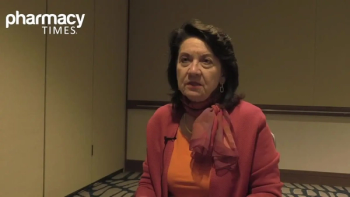
Assessing the Efficacy of Rucaparib for Treatment of Patients with Ovarian Cancer

Thomasina Morris, RPh, MHA, BCOP, pharmacist at Moffitt Cancer Center, discusses the efficacy of rucaparib for approved indications based on clinical trial results.
Pharmacy Times interviewed Thomasina Morris, RPh, MHA, BCOP, pharmacist at Moffitt Cancer Center, on how rucaparib is used to treat patients with ovarian cancer.
Thomasina Morris: So, with rucaparib, there are 3 different studies that were done to show efficacy for recovery in ovarian cancer. All the studies used a standard dosing of 600 milligrams orally twice a day. The first study was ARIEL2, and ARIEL2 was a single-arm open-label study.
Basically, this study allowed rucaparib to be looked at as from a safety standpoint and efficacious standpoint. When they looked at objective response rate of about 54%, they had complete response rate of about 9%, and then partial response rate of about 45%. So, in an ovarian patient, that's very phenomenal.
The other thing was, we had a median duration of response, which was 9 months. And most of the studies that we were looking at for most of the PARP inhibitors, they were going on 2 months and now have gone longer. So, the 9 months is a huge benefit for our patients. When we look at ARIEL3, now, ARIEL3 was different because it was a comparison of recovery and placebo. And what they wanted to do was to show where the median progression-free survival was, but they also looked at patients that were homologous recombinant deficient, which again, when we talked about actual things that patients might have that might stop the cancer from spreading, that is one of them. So that's a positive, and whether or not they have BRCA mutation.
So, in this study for ARIEL3, we found that the median progression-free survival was about 10 months versus 5 months with placebo. Now for the [homologous recombination deficiency] patients, we found that it was 13 months versus 5 months for placebo. And for the BCRA mutated patients, it was about 16 months versus 5 months. So, these patients that do have these different efficiencies or BRCA mutations benefit solely from PARP inhibitors.
The last study that was recently done was ARIEL4. ARIEL4 was different because it was looking at PARP inhibitor, or rucaparib, compared to standard of care chemotherapy. The patients had to be PARP naive, so no previous PARP treatment. So, what they were able to do is get the rucaparib 600 milligrams POV ID, and then the physician could then determine the chemotherapy treatment. Now this was a 2 to 1 double blind phase 3 study. So, in this arena, what we saw was that if they were platinum-sensitive, the investigator or the physician could use paclitaxel, 60 to 80 milligrams per meter squared, weekly, with a carboplatin or platin of their choice. If they were platin resistant, then it was just paclitaxel.
So, we found that with the progression-free survival, which is what the primary endpoint was, with rucaparib, it was about 7.4 months compared to chemotherapy, which was 5.7 months. The objective response rate was about 40% with the rucaparib and 32% with chemotherapy, and then the medium duration of response was about 9 months compared to 7.2 months, and the safety and efficacy of FISMA, the safety and the side effect profile was pretty much the same as it was in ARIEL2 and ARIEL3.
When people look at this study, or these studies in general, they determine that we can give our patients a good year of progression-free survival if they can tolerate it and stay compliant. The other thing that we must remember is when we look at some of these studies, we don't know in like ARIEL for what chemotherapy outside of the paclitaxel was used, was it carboplatin? Was it Gemzar or gemcitabine, or was its cisplatin and it was really provider choice? So, when we look at more information that will come through, I think rucaparib will still be the one that shows the higher percentage for the higher months for our ovarian cancer patients.
Newsletter
Stay informed on drug updates, treatment guidelines, and pharmacy practice trends—subscribe to Pharmacy Times for weekly clinical insights.

















































































































































































































